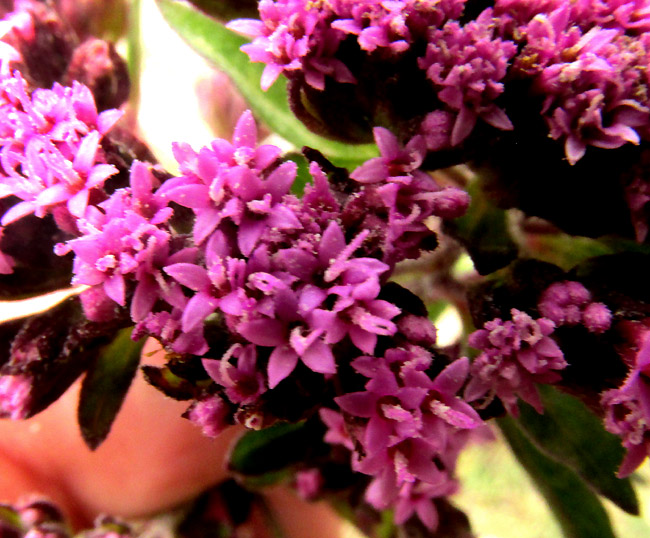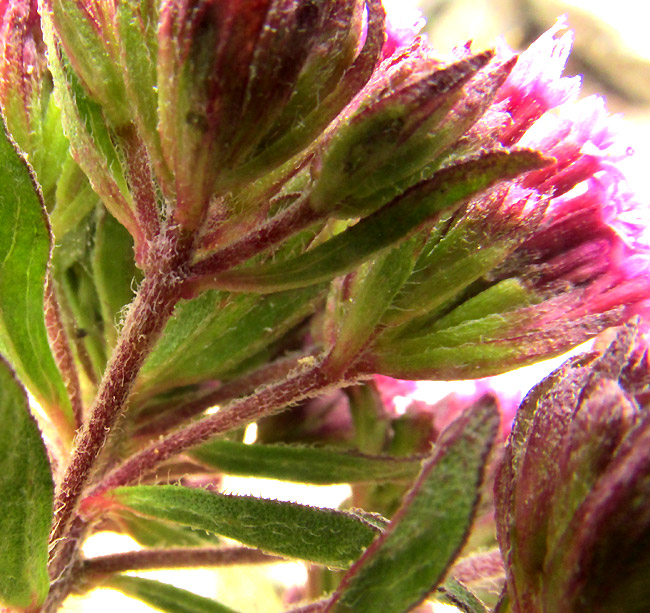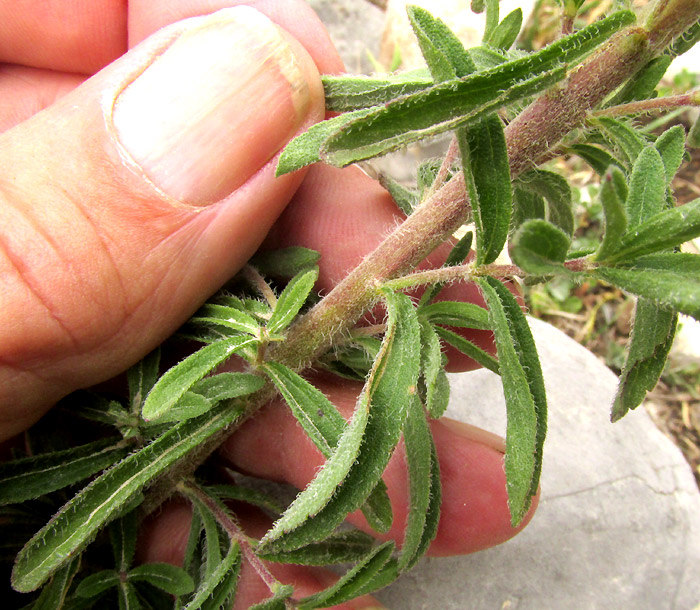Excerpts from Jim Conrad's
Naturalist Newsletter
Entry from field notes dated June 29, 2023, taken along one-lane gravel road in valley between Puerto del Zenthé and Chavarrías in mountainous area with a maze of roads too complex to say how to get there; in general it's in the mountains of east-central Querétaro state, municipality of Cadereyta de Montes, 12 straight-line kms due east of Vizarrón de Montes but much farther by twisting roads; juniper-scrub forest; limestone bedrock; elevation ~2860m (~9400 ft), Querétaro, MÉXICO, (N20.84122°, W99.60509°)
STEVIA PILOSA

On the valley floor in thin, rocky soil occupied with scattered junipers and agaves, and overgrazed by cattle, burros and sheep, the above knee-high plant was doing well. Note its slender leaves mostly arising singly at each stem node. Lower down, the stem is unbranched, but at the top numerous side branches bear flower clusters.

The flowering head at the top is organized into various clusters of 15-25 so flowers, with flower clusters at the side on long stems extending from lower down the stem.

Individual corollas are cylindrical at their bases but above divide into five lobes, appearing star-shaped from above. From the center of each corolla arises a slender style which is in the process of splitting into two slender style-branches; the flowers are young, just opening. In some of the above flowers, the branches have already separated.

At first what's shown above confused me. I'd been thinking that this was some species of valerian, such as the common, famously medicinal Garden Valerian, with its close-packed inflorescence, and individual flowers very similar to these. But, above, look closely at individual flowers in the larger cluster at the image's top, right corner. Below each lavender corolla there's a green, club-shaped item which apparently is an inferior ovary, the future fruit. Atop the most visible ovary, at the corolla's base, appear slender, dark-purple, hairlike things.
This arrangement looks like what's found in the Composite/Aster/Sunflower Family, the Asteraceae, not like what valerians display, which are members of the Honeysuckle Family, the Caprifoliaceae. In the Aster family, tightly packed florets arise from inside a bowl-shaped involucre composed of numerous scale-like bracts. The above cluster has a few loosely gathered, leaf-like blades which possibly could constitute a haphazard kind of involucre, but it certainly doesn't look like "normal" Aster-Family involucres with their neat series of scales.
So, here we have crammed-together disc florets -- not flowers -- with short, hairlike appendages atop their ovaries forming unusual pappi, and with truly remarkably sloppy-looking involucres. The Aster Family is the largest of all plant families, so it's perfectly capable of producing such oddities.

Finally, our plants' stems and leaves were conspicuously covered with long, soft hairs.
Taking into account that the leaves were simple with no lobes or large teeth, that no scale-like paleae separated the florets' ovaries from one another, the pappi consisted of short, spiky things but not long, hairlike or needle-like appendages, and the involucre comprised less than 5 bracts not lined up in series, our plants turned out to be the genus Stevia.
However, it's not the famous Stevia sometimes called Candyleaf, Sweetleaf, Sugarleaf or other such sugary names, and whose leaves are the source of extracts used as low-calory sweeteners in commercial products; that's Stevia rebaudiana, of Brazil and Paraguay. Over 300 Stevia species are recognized, and all native to the Americas. According to Erika Villagómez-Flores and others in the 2018 work El género Stevia (Eupatorieae, Asteraceae) en el estado de Morelos, México, 116 Stevia species occur in Mexico.
Also in that publication it's emphasized that identification of Stevia species can be very complicated because many of the species aren't clearly delimited, they hybridize with one another, and often reproduce apomitically -- asexually producing offspring genetically identical to the parent plant.
Stevia species haven't been closely studied in this part of upland central Mexico, but from various sources, and by matching our plants with pictures on the Internet, I'm fairly sure that our plants in the overgrazed rocky scrub are STEVIA PILOSA, which is endemic just to Mexico. It occurs in highland oak/pine forests and scrubby areas like ours, mostly in the Eastern Sierra Madres and central Mexico, and scattered farther west.
Stevia pilosa, with no English name, is variously used in traditional herbal medicine. The 2020 study by Elizabeth Martínez-Rojo and others entitled "Stevia Eupatoria and Stevia Pilosa Extracts Inhibit the Proliferation and Migration of Prostate Cancer Cells" found that extracts from our plants inhibited prostate cancer cells.
Angiosperms, or flowering plants, arose about 125-100 million years ago, and the first Aster-Family members crystallized about 88-89 million years ago. The 2017 gene study by Akiko Soejima and others entitled "Phylogeny and biogeography of the genus Stevia (Asteraceae: Eupatorieae): an example of diversification in the Asteraceae in the new world," found that the first recognizable species of Stevia arose in Mexico only 7.0-7.3 million years ago. Therefore, the theory I was toying with that our plant's disorganized-looking involucral bracts suggested an ancient origin, back before Aster-Family details were nicely worked out, seems to be wrong. These are fairly modern creations. Maybe they represent a growing insight within the family that systematically organized involucral bracts aren't as important as at first thought.